Ford Mustang Mach-E Vs Tesla Model Y Comparison

Welcome to the next level of the domestic head-to-head battle.
In the red corner is the Ford Mustang Mach-E. Much has been said about Ford’s dedicated electric-only pony. No matter which side of the is-it-a-real-Mustang debate you fall on, you can’t deny the Mach-E has shaken up the segment, demanding attention in a segment that will get very crowded, very soon.
In the other red corner is the car that Ford so clearly targeted with the Mach-E: the Tesla Model Y. Tesla had first-mover advantage here, and yet the Model Y still holds the edge in (EPA quoted) range, to say nothing of its brand recognition. Tesla is practically synonymous with EVs, like Coca-Cola to pop or Kleenex to tissue paper. Not one of the people that stopped to ask me about the Mach-E did so without invoking the T-word. And there were many of them.
Get a Quote on a New Ford Mustang Mach-E or Tesla Model YSo we did the only thing we could do: we pit these two mid-size all-electric crossovers against one another. What resulted surprised us.
Editor’s Note: Due to the lack of a Tesla press fleet in Canada, we plucked a Model Y Long Range from the Turo fleet in Toronto. We picked the closest spec-for-spec model for this comparison: a 2021 Model Y Long Range AWD. It had less kilometers under its wheels than the Mach-E tester.
Interior and Cargo Space
Mustang Mach-E: Ford went back to the drawing board for the Mach-E’s interior, resulting in a space that doesn’t have much in common with the rest of the Blue Oval lineup. That’s what makes it such a breath of fresh air.
Like most EVs out there, the Mach-E pushes its tech-forward angle with a honking great touchscreen smack dab in the middle of the cabin, and little else. Someone at Ford evidently couldn’t settle for second, so the Mach-E’s screen has a half-inch on the Tesla’s 15.0-inch unit. There’s a second screen located ahead of the steering wheel too, offering up key information clearly in the driver’s line of sight. The cloth lining the top of the dash is a welcome touch, introducing a bit of warmth into a sparse cabin. The center console houses the familiar Ford rotary drive selector, two sizeable cupholders, and up ahead, a wireless charger.
SEE ALSO: 2021 Ford Mustang Mach-E Review: EV Power to the PeopleOur tester features a black leather interior with red contrast stitching. I prefer the Mach-E’s seats to the Tesla’s, on account of the greater lower back and thigh support. Both of these vehicles feature glass roofs, but the Mustang’s starts a little further back, robbing front occupants of that airy feeling. Second-row folks get the whole high-def treatment though, which makes up for a tighter 38.2 inches (970 mm) of headroom. In fact, despite what the tape measure says, the Mach-E feels more adult-friendly in the back.
Ford quotes 29.7 cubic feet (841 liters) of storage space behind the second row. Fold the rear seats down and that grows to 59.7 cubes (1,691 L). The frunk offers up an additional 4.8 cubic feet (136 L).
Model Y: Like the Ford, the Tesla is all about stark minimalism—just more so. Beyond the too-small steering wheel, there’s little in the way of curves here: the dashboard is merely a spar of plastic and wood spanning the width of the cockpit. If car interiors were video game character creator modes, the Model Y’s would be the default setting.
Build quality is notably better than the last Tesla we drove ( a 2019 Model S). The Model Y still can’t match the craftsmanship of the legacy automakers. On the highway, there would be an intermittent rattle from the rear tailgate. Every time the Model Y went over even a middling bump, the rear seats would creak and groan. A simple storage cubby below the touchscreen is huge, but its lid looks and feels cheap to operate. None of these things may be dealbreakers in isolation, but the arrival of the Mach-E should serve as a reminder that Tesla still has work to do.
SEE ALSO: Porsche Taycan vs Tesla Model S ComparisonFront row comfort is high, with well-bolstered thrones holding driver and passenger in place. The glass roof starts closer to the front row’s field of vision, adding to the sense of airiness. In fact, the Tesla offers more space in practically all directions, though it may not always feel like it. I can’t imagine what the available third row must feel like. Second-row passengers have a full 39.4 inches (1,001 mm) of headroom, and legroom is slightly more than that. Tesla quotes a total storage space, with second row folded flat, of 68.0 cubic feet. (1,926 L).
Bottom Line: Tesla’s build quality continue to improve, but even this fairly-fresh privately-owned model felt a little rough around the edges. There were rattles and other noises where there shouldn’t have been. Every time the rear seats would judder over bumps, it would nibble away at the Tesla’s premium feel. That was never the case with the Mach-E, which felt properly screwed together and drum-tight. Despite it being slightly less spacious by the numbers, the Mustang never felt as much, with an airy cabin and more interesting interior design. That pointy pony-badged nose edges ahead in the first category.
Tech and Features
Mustang Mach-E: The Mach-E’s larger screen makes a strong first impression. The resolution is high, the design is stylish, and that integrated volume knob is an eye-catcher. In practice, SYNC 4 has a slightly steeper learning curve than the system found in the Model Y. There’s just a hint of lag in the Mach-E’s responses, and it can’t multitask in the same way the Tesla can show navigation and other information. Ford deserves recognition for keeping the climate controls on screen at all times, however.
Another benefit the Mustang can lord over the Model Y is its standard wireless Apple CarPlay and Android Auto. If you’re more comfortable with your phone’s interface, only the Mustang lets you mirror it inside the car.
When they’re not inside the car, owners can also access numerous features of the Mach-E via the FordPass app, including pre-charging, setting future destinations, and prepping the climate control.
Ford hasn’t forgotten about rear-seat passengers’ tech needs, throwing a pair of USB outlets back there; one Type-A, one Type-C.
Model Y: You see that big 15.0-inch screen in the center of the dashboard? You’ll want to get familiar with it, because that touchscreen handles very nearly every possible command inside the Y. It can be a little overwhelming at first, but spend 15 minutes familiarizing yourself with the menus before setting off and it’s surprisingly intuitive. The layout is clean, important touch points are spaced out to minimize error-jabs, and it all moves without a hint of lag. It’s pretty slick, and it’s of little surprise that those used to flicking and swiping around tablets dig this approach.
There are limitations, however. For starters, adjusting the side mirrors is very clumsy, requiring the driver to use the steering wheel. What’s wrong with door-mounted controls? Centralizing all controls across an ever-changing screen means you’ll still need to look away from the road to do much of anything, too. Tesla also doesn’t want you playing with anybody else’s toys: there’s no Android Auto nor Apple CarPlay support here. That being said, there are apps for Spotify and Netflix. The native navigation works well, and crucially, it can stay on the screen while you handle another task.
Like the Mach-E, the Model Y includes a pair of USB ports for the second row, in this case both USB-C.
Tesla also includes a whole bunch of, well, gimmicks. Yes, it’s true, the Mustang doesn’t offer the ability to fart on command. That’s a positive as far as I’m concerned. I’m also going to keep banging the every-car-should-have-an-on-off-button drum.
Bottom Line: Ford has had to take on a Silicon Valley giant here, and it’s done an admirable job. Having a second screen does wonders for its learning curve, too. Tesla’s operating system is still the superior choice though,
Powertrain, Driving Feel, and Range
Mustang Mach-E: Until the Mustang Mach-E GT arrives later this year, the AWD Extended Range model is the top dog. With 346 hp and 428 lb-ft of instant-on torque, the Mach-E is plenty quick for everyday driving. There are three driving modes: Whisper (Eco), Engage (Normal), and Unbridled (Sport). Knocking it over to Unbridled wakes this electric pony up, sharpening the go-pedal responses and adding some needed heft to the steering wheel.
The Mustang’s steering ratio is a comparatively slow 14.6:1. At 2.7 turns lock-to-lock, it needs a fair amount of twist applied to really bite into a corner. Once it does, though, the Mustang is a tidy handler. It’s hefty, but the weight is all low down in the chassis, and the narrow 225-section tires mean grip levels are modest. The Mach-E is equal parts entertaining and approachable; it’s certainly more fun on the tarmac than any other Ford crossover.
SEE ALSO: Genesis GV80 vs BMW X5 ComparisonPressed into the daily grind, the Mach-E does an admirable job of smoothing out rutted Toronto tarmac. There’s a depth to its dampening, always keeping the Mach-E composed no matter what the road throws at it. There’s a firm, controlled edge to the ride, an always-there reminder of the name this four-door electric crossover shares with a two-door sports coupe.
Due to the limited time we had these two together, we couldn’t pull off an apples-to-apples range comparison. The Mustang ended up averaging a little less than 22.0 kWh per 100 km, which translates to around 250 miles (400 km) per charge—shy of the EPA-rated 270 miles (435 km).
Model Y: The Model Y feels quicker than the Ford the very first time you lay into the right pedal. It’s not vastly more powerful on paper—384 hp, and less torque at 375 lb-ft—but the Model Y is lighter, helping it off the line. This isn’t even the Performance version, either.
No doubt helping put that power down is an extra inch of rubber at all four corners. The Model Y wears 255-section rubber, resulting in a car that refuses to unstick from the road—and only a small increase in tire noise over the ‘Stang. Flipping expectations on their head, it’s the Tesla’s tiny steering wheel that offers more weight and feedback of the duo, at least in its softest setting. It has the tighter steering ratio as well (10.3:1), making it feel eager to tip into corners.
It’s when the tarmac isn’t as smooth as the Model Y’s dashboard design that cracks start to appear. The ride becomes brittle, deteriorating just like Toronto’s own Gardiner Expressway. Over one particular yump on my preferred test route, the Model Y bucked me clean off the seat.
We drove the Model Y around 100 miles (160 km) during its time with us. In that time it drained 34-percent battery, which suggests a real-world range of 292 miles (470 km).
Bottom Line: This is a tough category to call. Despite the Ford’s name, it’s the Tesla that feels sportier, insofar as it’s quicker in a straight line and has tighter steering. The Mustang’s narrower tires make it the more playful steer in the corners too, allowing for fun at speeds that won’t threaten your license. By comparison, the Tesla is more buttoned-down and one-dimensional in its cornering attitude. More importantly, the Ford is the smoother ride during around-town errand-running. That’s what will matter to more people more of the time.
On the other hand, unless you’re charging at home all the time, the Tesla Supercharger system remains second to none. The Ford has access to more stations, but you’re at the mercy of whomever is (or is not) taking care of them.
Safety
Mustang Mach-E: At the time of writing, the National Highway Traffic Safety Administration (NHTSA) had yet to score the Mach-E. The Insurance Institute for Highway Safety (IIHS) did, however: it awarded the Mustang a Top Safety Pick designation. The battery-powered Blue Oval machine just misses out on the Top Safety Pick+ badge, all down to the headlights on the Select and California Route 1 trims. A vehicle needs an Acceptable or Good headlight rating across the lineup to earn that little plus sign—which the other trims achieve, it should be noted.
Ford includes Co-Pilot360 2.0 on every 2021 Mustang Mach-E. This counts pre-collision assist with automatic emergency braking, lane-keep assist, blind-spot detection with cross-traffic alert, and reverse brake assist amongst its lineup of driver aids. Adaptive cruise control is also part of the package, as is a 360-degree camera on this tester. Ford’s own hands-free semi-autonomous highway driving system, called BlueCruise, will debut later this year. BlueCruise will work on over 100,000 miles of pre-mapped, divided highways in North America.
Model Y: The Model Y aces the tests at both the NHTSA and IIHS. It’s a full 5-star vehicle at the former, including the tough-to-ace rollover test. Meanwhile, the IIHS has given Tesla’s latest the full Top Safety Pick+ sticker of approval. That comes with its own asterisk, though: the TSP+ rating only applies to Model Ys built before May 2021. Tesla switched to its radar-less Tesla Vision system starting that month, and the IIHS has yet to test the new system.
This tester comes with the pricey “Full Self-Driving” package. I tested it twice on the highway, with my hands on the wheel at all times. It does a convincing job of driving like a (cautious) human on the highway, and the first time the Model Y signals to make an automatic lane change, cancels because of a fast-approaching car, then pulls it off after the car has passed, you will nod in approval. That said, the system would disengage without any warning, so it’s clear there’s still work to be done. The regular sort of driving assists, such as automated emergency braking, lane departure warning, and blind-spot monitoring are all standard.
Bottom Line: Dubiously-named assists aside—Full Self-Driving is anything but—you can’t argue with the Model Y’s safety test results. It passes with flying colors, and even if the Mach-E matches it after the NHTSA’s battery of tests, its lower trims hold it back at the IIHS. Another point for Elon and the team.
Styling
Mustang Mach-E: As I said in my recent review of the Mach-E, nothing I’ve driven this year has drawn as much attention as this thing. Wheeling both of these oversized hatchbacks around the city, the Model Y might as well have been invisible.
Away from the autoshow floors of its debut, the Mach-E looks more natural now. It’s certainly the more aggressive of the two vehicles, with its angry headlights, big roof mounted wing, and the latest evolution of the Mustang’s iconic three-bar taillights. The pony car styling cues work on this shape, though the rear three-quarter view highlights the sheer amount of metal between the rear wheels and the window line. The clean flanks and body-color wheel arches give the Mach-E a more expensive, urbane look than the timid Tesla, too.
Model Y: When the Model Y first launched, a meme floated around the internet showing a Model 3 simply being vertically stretched in Photoshop. That’s ridiculous, of course: Tesla lined the wheel arches with some black plastic, too. Jeez, c’mon guys.
In all seriousness, having both of these rides in a near-identical shade of red makes it easier to pinpoint where they differ. The Model Y has an overall cleaner look, and that cladding isn’t for nothing: the Tesla has more ground clearance. The family face makes it easily recognizable, though the flip-side of Tesla’s EV dominance is that it also feels much more common. Personally, I’m a big fan of the chunky aero wheels, too.
Bottom Line: The Ford is all novel and new, whereas the Tesla is friendlier and familiar. Our entirely scientific approach of driving around downtown Toronto with the windows down suggests more people favor the Mustang—but your tastes are your own.
Pricing
Mustang Mach-E: The Mustang Mach-E lineup begins at $43,995 ($52,395 CAD) for the rear-drive, standard-range Select trim. That’s before you factor in available federal EV incentives too, something Tesla is no longer eligible for in America. In this form, the Mach-E uses a single motor good for 266 horsepower and 428 lb-ft of torque, enough to propel it to 60 mph (97 km/h) in 5.2 seconds. Range is 230 miles (370 km).
Moving up to the Premium trim ($48,700 / $61,490 CAD) is where the options for both AWD and the larger battery open up. Spec both and you’ll find another $7,700 ($10,500 CAD) tacked onto the bottom line. Our First Edition tester goes further still, at an as-tested price of $62,160 ($74,045 CAD). It amounts to a few unique visual upgrades inside and out. Pairing the 88-kWh battery with AWD results in a 270-mile (435 km) range; stick to rear drive and it’s an even 300 miles (483 km) for the Premium, and 305 miles (491 km) for the California Route 1.
Model Y: Tesla keeps the Model Y lineup much simpler, currently offering two flavors: Long Range and Performance. Both use a dual-motor, electronic-AWD setup similar to the Mach-E. Long Range models like our tester list for $53,690 ($69,990 CAD), including destination. For that sum, you’ll find a 384-horsepower, 346-lb-ft Model Y capable of 326 miles (525 km) between charges, and a dash to 60 mph (97 km/h) in 5.0 seconds. At-cost options are limited to larger 20-inch wheels, a tow hitch, and an additional third row of seats. Any exterior color choice other than white will set you back a grand or two as well. The other big spend, which this car has, is the “Full Self-Driving Capability” option, for a cool $10,000 ($10,600 CAD).
Tesla will also sell you a Model Y Performance for $62,190 ($83,990 CAD). Horsepower is up to 450, torque increases to 471 lb-ft, and range drops slightly to 303 miles (488 km). The Performance slices a full second and a half off the Long Range’s run to 60 mph, too. The upcoming Mach-E GT is the closer match for this one.
Bottom Line: With the short-lived Model Y Standard Range gone, the Mach-E has the starting-price advantage. It also offers more variations, making it easier for EV buyers to tailor the package to their needs and wants. More pertinently, the Mustang also holds the edge in the as-tested category.
Verdict: Ford Mustang Mach-E vs Tesla Model Y Comparison
A few years ago, ICE evangelists decried the oncoming EV revolution. They feared every car would feel the same, a facsimile of a facsimile of the dull compliance vehicles manufacturers had to churn out. Yet here we are with two vehicles close on price, power, performance, shape, and even color—and yet they feel distinct from one another behind the wheel.
The Model Y feels more appropriate for those who see driving only as a necessity. The Tesla takes the sting out of the daily grind at every turn, either through its addictive point-and-shoot power or the myriad goodies in its digital toy chest. Factor in the superior Tesla Supercharger grid, and from a wholly dispassionate, facts-over-feelings perspective, the Model Y is the pick here.
We refuse to believe people dropping this amount of coin on shiny new mid-size crossovers are shopping that way, though. The Mach-E appeals to the heart as much as the head; its real-world range is very nearly on par with the Tesla, and its more entertaining behind the wheel. The Model Y’s competence has made it ubiquitous and, at least on this day, we prefer the newcomer.
Become an AutoGuide insider. Get the latest from the automotive world first by subscribing to our newsletter here.

Kyle began his automotive obsession before he even started school, courtesy of a remote control Porsche and various LEGO sets. He later studied advertising and graphic design at Humber College, which led him to writing about cars (both real and digital). He is now a proud member of the Automobile Journalists Association of Canada (AJAC), where he was the Journalist of the Year runner-up for 2021.
More by Kyle Patrick



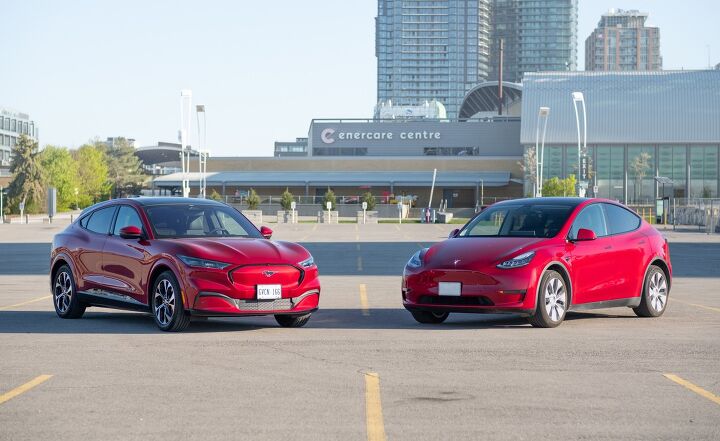
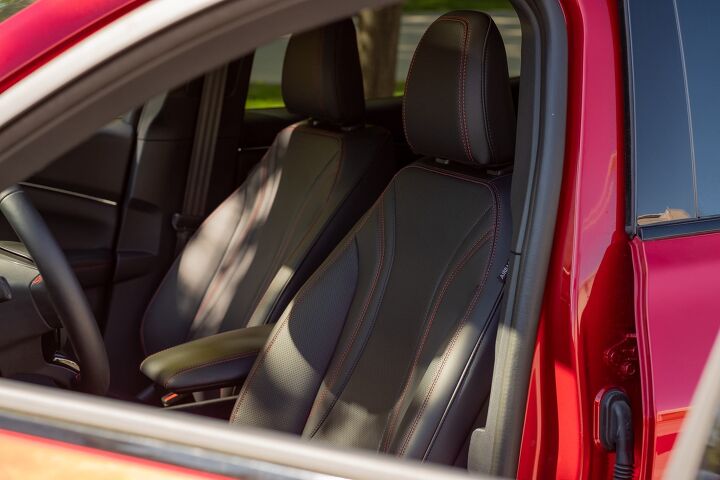

























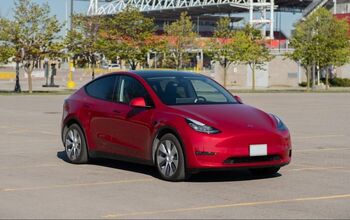


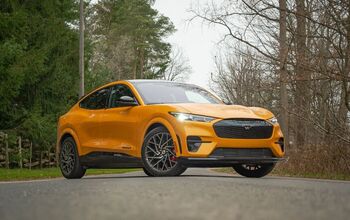
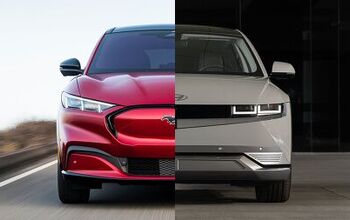


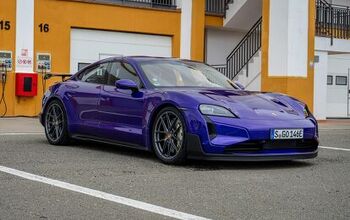

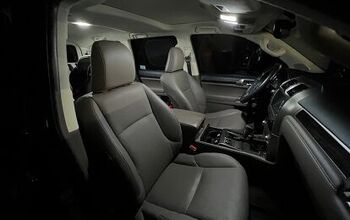
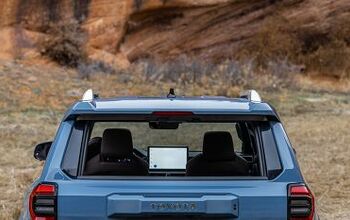


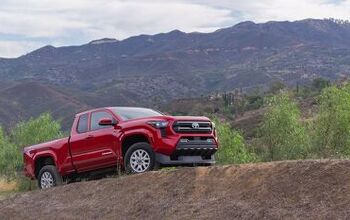
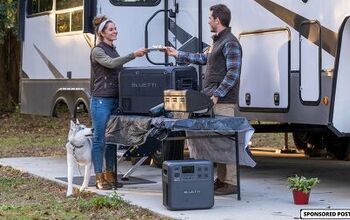
Comments
Join the conversation